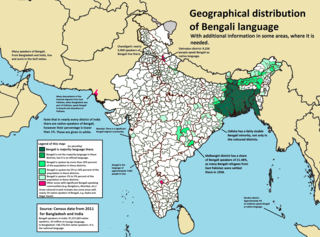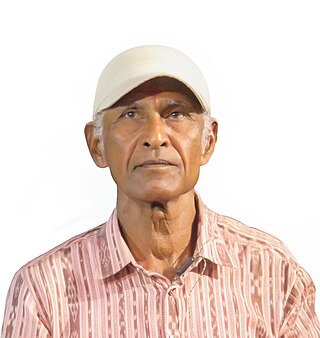Related Research Articles

Hausa is a Chadic language that is spoken by the Hausa people in the northern parts of Nigeria, Ghana, Cameroon, Benin and Togo, and the southern parts of Niger, and Chad, with significant minorities in Ivory Coast. Smaller minorities of speakers exist in Sudan.

The Indo-Aryan languages are a branch of the Indo-Iranian languages in the Indo-European language family. As of the early 21st century, they have more than 800 million speakers, primarily concentrated in India, Pakistan, Sri Lanka, Bangladesh, Nepal and Maldives. Moreover, apart from the Indian subcontinent, large immigrant and expatriate Indo-Aryan–speaking communities live in Northwestern Europe, Western Asia, North America, the Caribbean, Southeast Africa, Polynesia and Australia, along with several million speakers of Romani languages primarily concentrated in Southeastern Europe. There are over 200 known Indo-Aryan languages.

Languages spoken in the Republic of India belong to several language families, the major ones being the Indo-Aryan languages spoken by 78.05% of Indians and the Dravidian languages spoken by 19.64% of Indians; both families together are sometimes known as Indic languages. Languages spoken by the remaining 2.31% of the population belong to the Austroasiatic, Sino–Tibetan, Tai–Kadai, and a few other minor language families and isolates. According to the People's Linguistic Survey of India, India has the second highest number of languages (780), after Papua New Guinea (840). Ethnologue lists a lower number of 456.

Odia is an Indo-Aryan classical spoken in the Indian state of Odisha. It is the official language in Odisha, where native speakers make up 82% of the population, and it is also spoken in parts of West Bengal, Jharkhand, Andhra Pradesh and Chhattisgarh. Odia is one of the many official languages of India; it is the official language of Odisha and the second official language of Jharkhand.
Baga, or Barka, is a dialect cluster spoken by the Baga people of coastal Guinea. The name derives from the phrase bae raka Slaves trading place and understood by the local as 'people of the seaside' outcasted people. Most Baga are bilingual in the Mande language Susu, the official regional language. Two ethnically Baga communities, Sobané and Kaloum, are known to have abandoned their (unattested) language altogether in favour of Susu.

Sambalpuri is an Indo-Aryan language variety spoken in western Odisha, India. It is alternatively known as Western Odia, and as Kosali, a recently popularised but controversial term, which draws on an association with the historical region of Dakshina Kosala, whose territories also included the present-day Sambalpur region.

Bengali, also known by its endonym Bangla, is an Indo-Aryan language native to the Bengal region of South Asia. With approximately 240 million native speakers and another 41 million as second language speakers as of 2021, Bengali is the sixth most spoken native language and the seventh most spoken language by the total number of speakers in the world. It is the fifth most spoken Indo-European language.
The first ever Sambalpuri movie released was Bhukha. It was released in the year 1989 and was directed by Sabyasachi Mohapatra. It was also the first film from Odisha to get an International Jury Award at the Gijon International Film Festival. The second film in Sambalpuri language is Ulugulan (Revolution), which was released in 2008, directed by Mahmood Hussain and produced by Purnabasi Sahu. Its story is set in the first half of the 18th century and depicts the tyrannical rule of the Nagpur rulers.

Dr. Haldhar Nag is a Sambalpuri poet and writer from Bargarh, Odisha, India. Popularly known as "Lok Kabi Ratna". He was awarded Padma Shri, the fourth highest civilian award of India by Government of India in 2016.

Sabyasachi Mohapatra is an Indian film director, writer, and producer in Odia cinema. He owns a production house named Mohapatra Movie Magic.

Baleswari Odia, also Northern Odia or North Balasore Odia, is a dialect of Odia spoken in the northern regions of Indian state of Odisha. It is spoken in the districts of Balasore, Bhadrak, Mayurbhanj and Kendujhar.
Sambalpuri Odia drama are a typical drama performance in Sambalpuri Odia language of Odisha, India.
Juray is a Munda language of India, spoken in Gajapati district in southern Odisha. It is very close to Sora: Gregory Anderson (2008:299) considers Juray to be a Sora dialect. It is currently severely endangered.
Tainsar is a village & it comes in the range of Tileibani block of Debagarh district of Odisha, an eastern state of India. It is home to around 250 families. A mixture of pure Odia and Sambalpuri(a dialect of Odia) is spoken(known as Debagarhia) in the village. Farming is a common practice in the village.
Kiorr is a Palaungic language of Luang Namtha Province, Laos.
Sinapali is the main town in Sinapali Tehsil in the south of Nuapada District in Odisha, India.
Glottolog is a free online bibliographic database of the world's languages. In addition to listing linguistic materials describing individual languages, the database also contains the most up-to-date language affiliations based on the work of expert linguists.
The Eighth Schedule to the Constitution of India lists the official languages of the Republic of India. At the time when the Constitution was enacted, inclusion in this list meant that the language was entitled to representation on the Official Languages Commission, and that the language would be one of the bases that would be drawn upon to enrich Hindi and English, the official languages of the Union. The list has since, however, acquired further significance. The Government of India is now under an obligation to take measures for the development of these languages, such that "they grow rapidly in richness and become effective means of communicating modern knowledge." In addition, candidates sitting for an examination conducted for public service are entitled to use any of these languages as a medium to answer the paper.

Jitendra Haripal, a singer, is most popularly known for his voice in the famous and super hit Rangabati Song in Sambalpuri language of Odisha. He sang this duet song with his female co-singer Krishna Patel. He has sung over 1000 songs and regarded as a top exponent of Sambalpuri language song. He has shared the stage with other leading artists of the State including the former Chief Minister Giridhar Gamang, himself a fine musician. He received the Padma Shri, the fourth highest civilian award of India from the Government of India in 2017 for his contribution to the Indian Music.
Desia, also Desiya or Desia Odia or Koraputi Odia or Southwestern Odia, is an Indo-Aryan language variety spoken in Koraput, Nabarangpur, Rayagada, Malkangiri districts Odisha and in the hilly regions of Vishakhapatnam and Vizianagaram districts of Andhra Pradesh. The variant spoken in Koraput is called Koraputia.
References
- ↑ Agariya at Ethnologue (18th ed., 2015) (subscription required)
- ↑ "Untitled Document". ciil-ebooks.net. Retrieved 15 March 2024.
- ↑ "A BRIEF HISTORY OF AGHARIA CASTE - PDF Free Download". docplayer.net. Retrieved 15 March 2024.